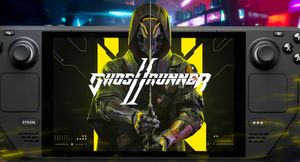Here's how One More Level's cyberpunk hack and slash follow-up fares on Valve's portable PC.
Exactly three years after the release of critically acclaimed action-platformer Ghostrunner, Polish developer One More Level lets us return to slash through countless enemies and wall run across a gritty cyberpunk world.
Compared to its predecessor, Ghostrunner 2 is no less challenging and maintains its similarly fast-paced gameplay — so you'll want to ensure you’re playing with the best possible performance, especially on a handheld like the Steam Deck.
Awakening the inner Cyber Ninja
When starting the hefty 66GB game for the first time on Steam Deck, you’ll be greeted with the choice between DirectX 11 and DirectX 12. Initial testing reveals that the latter is the better option here: Somehow, there are far more stutters during combat on DX11 (which almost feel like constantly recurring shader compilation hiccups).
The intro sequence showed exactly that, as you can see below: DirectX 12 (in green) is much more stable, which might be the result of more efficient asset decompression.
The title and main menu screen are not representative of the real in-game performance at all. One More Level opts to flex with an initial animated scene, showing a detailed background and cyber-samurai jack ready for combat in the foreground.
This particular scene is a massive challenge for the Steam Deck’s APU, albeit actively adapting to changes in the graphics settings. Varying between 30 and 40 FPS, this scenario shouldn’t discourage you. The moment you jump into the actual game, you’ll end up in the surprising range of high 50s.
The game’s amazing optimization for the Steam Deck truly caught me off-guard, hovering between 50 and 60 FPS most of the time on a mix of medium settings. The developers told me about their focus on Valve’s handheld when I met them in-person in Cologne at gamescom this August, however I never expected the outcome we see here. Downright amazing.
You’ll see the biggest performance drops in transitioning between the bigger level areas. While boasting great frame pacing most of the time, the moment the Van Gogh chip has to pull new environmental data, the FPS can dip down to around 40 FPS, reaching low 30s in the worst scenario.
The same applies for in-engine cutscenes, which sometimes drop the frame rates down to 28 FPS. In my books, this doesn’t disrupt the game’s main flow: Fast-paced combat sees occasional stutters, especially when encountering certain enemy variations with more GFX involved — but manages to stay stable otherwise.
Traversal — when Jack is not wall running, sliding, or driving between two main areas at that exact moment — sees similar performance throughout the game’s main campaign, let alone the new roguelike mode without major cutscenes. Sure, we could try to lock to a set frame rate between 30 and 40, but this would be a tremendous price that would take a massive toll on the fast-paced gameplay.
That being said, when benchmarking the default settings, I’ve noticed a fair amount of rendering headroom: Some settings could’ve been raised a good amount, when adapting to different performance targets, while others come with an unnecessary price not worth their results.
Walking on the Blade’s Edge
After slashing through countless enemies, taking on a deadly AI cult, driving on the walls of huge skyscrapers on a sick motorcycle, and dying again and again — mostly exclusively on Steam Deck — I’ve come to the following conclusion: Taking a painful cut to the responsive action of Ghostrunner 2 by limiting the game’s framerate to anything lower than 50 FPS would diminish most of the sequel’s fun, let alone overall responsiveness.
I wouldn’t even blame you if you’re the type of person that lowers the game's visuals, unlocks the frame rate and calls it a day. That would be a totally valid route in this case, thanks to the amazing optimization work by One More Level. But I can’t shake the feeling that the impressive world of Ghostrunner 2, with its gritty cyberpunk-style city canyons and vibrant vistas, deserves to shine — even on a seven inch handheld screen.
Therefore, I’ve opted to experiment with improved visuals while targeting 50 FPS. Et voila, protagonist Jack is wall-running and slashing through impressively atmospheric sceneries, while enjoying surprisingly consistent performance.
Keep in mind that FSR2 definitely comes in handy, but it does reveal its weak spots in a fast-paced game such as this action platformer. Objects with fast movements will exhibit some ugly upscaling noise, but that’s a more than acceptable price to pay for the overall performance package seen here. Even with FSR2 set to 'Quality', we can’t eliminate this effect, so we either roll with it — or resort to Intel XeSS.
Intel’s upscaler would give you an overall softer look than FSR2, with fewer upscaling artefacts, but you’d have to resort to 'Balanced' to achieve a similar frame pacing to wattage ratio comparable to the result of FSR2 'Quality'. This again significantly impacts the game’s appearance, by lowering the base resolution far lower than what AMD’s temporal upscaler would utilise. In short, XeSS at 'Ultra Quality' looks amazing, but consumes more wattage.
(Thankfully, setting 'Blur' to 'Epic' helps at least with the aforementioned noise issues)
However, there’s still the elephant in the room with fuzzy meshes, particularly noticeable with fences or distant objects in general: FSR2’s algorithm is so aggressive that it loses some finer details of more granular objects. It’s hard to reproduce this effect in still images, but you can still make out the obvious differences below:
As I personally appreciate the craftsmanship of One More Level’s artists and would love to maintain as much visual quality as possible, I would rather accept higher power output and therefore less battery life, in exchange for improved clarity thanks to XeSS set to ‘Ultra Quality’. To slightly reduce the load, I’d recommend setting the FoV to 75°.
Best Settings for Ghostrunner 2 on Steam Deck
Taking all findings and tweaks into account, you can expect a battery life of one and a half hours when playing Ghostrunner 2 on Steam Deck.
These are the best settings for Ghostrunner 2 on Steam Deck:
| In-game Settings | |
|---|---|
| Window Mode | Fullscreen |
| Resolution | 1280 x 800 |
| Intel XeSS | On |
| Intel XeSS Mode | Ultra Quality / Quality |
| Post Process Quality | High |
| Shadow Quality | Medium |
| Textures Quality | High |
| Effects Quality | Medium |
| Blur | Epic |
| Gore Effect | On |
| Frame Rate Limit | Unlimited |
| V-Sync | On |
| Field of View | 78 |
| Quick Action Menu | |
|---|---|
| Framerate Limit | Off |
| Refresh Rate | 50Hz |
| Allow Tearing | Off |
| Half Rate Shading | Off |
| TDP Limit | Off |
Unlocking the frame rate and applying 60Hz would, of course, result in more fluid gameplay, but also would take a fair toll on battery life while further introducing larger FPS dips overall.
Then again, this means you could also limit the framerate to 45 or even 40 by lowering the refresh rate accordingly, in order to save more battery — when, for example, commuting or travelling. But don't expect to easily sweep through the really challenging levels without dying countless times that way. Responsiveness is key.
Conclusion
As mentioned before, I’m incredibly impressed by the excellent optimization work on display here.
When meeting up with the small, passionate developer team for a hands-on a few months ago, I definitely appreciated their optimistic tone when asking about Steam Deck performance specifically. Most developers wouldn’t want to admit that Valve’s handheld doesn't provide much wiggle room. But the end result left me in awe — especially considering the team’s small size — and I wish similar optimization results could be seen in other games.
Ghostrunner 2 is an amazing sequel, boasting adrenaline-fueled action, successfully building on the foundations of Jacky’s first adventure. I’m not exaggerating when I tell you the Gamescom demo left me hyped for more — which you could hardly blame me for if you’ve seen the game’s motorcycle sequences alone.
The fact that the final product not only delivered on these promises but also boasts such impressive performance is a breath of fresh air in a landscape riddled with botched PC releases. Hell of a job, One More Level. Seriously, you nailed it.




